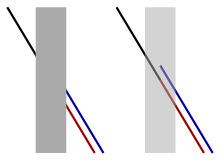Illusion de Poggendorff

L'illusion de Poggendorff est une illusion d'optique baptisée ainsi en hommage au physicien Johann Christian Poggendorff qui l'a découverte en à la suite d'un courrier de Johann Karl Friedrich Zöllner lui présentant l'illusion de Zollner[1].
Dans l'illustration ci-contre, notre cerveau perçoit mal l'interaction entre les lignes diagonales et la bande grise verticale. Une ligne noire est masquée par un rectangle gris foncé. La ligne bleue apparaît comme celle continuant la ligne noire alors qu'en réalité c'est la ligne rouge.
Voir aussi
[modifier | modifier le code]Notes et références
[modifier | modifier le code]- (de) Johann Karl Friedrich Zöllner, « Ueber eine neue Art von Pseudoskopie und ihre Beziehungen zu den von Plateau und Oppel beschrieben Bewegungsphaenomenen », Annalen der Physik, vol. 186, , p. 500-25 (DOI 10.1002/andp.18601860712, lire en ligne).
- (en) Westheimer G, Wehrhahn C., « Real and virtual borders in the Poggendorff illusion », Perception, vol. 26, no 12, , p. 1495-501 (DOI 10.1068/p261495)
- (en) Greist-Bousquet S., Schiffman H. R., « The Poggendorff illusion: an illusion of linear extent? », Perception, vol. 10, no 2, , p. 155-64 (DOI 10.1068/p100155)
- (en) The Poggendorff Illusion as a Constancy Phenomenon, « Green R. T., Hoyle E. M. », Nature, vol. 200, , p. 611 - 612 (DOI 10.1038/200611a0)
- (en) M. J. Morgan, « The Poggendorff illusion: a bias in the estimation of the orientation of virtual lines by second-stage filters », Vision Research, vol. 39, no 14, , p. 2361-2380 (DOI 10.1016/S0042-6989(98)00243-0)
- (en) R. L. Gregory, « Perceptual Illusions and Brain Models », Proceedings of the Royal Society of London Series B, vol. 171, no 1024, , p. 279-296 (lire en ligne)
- (en) Day, R. H., « The oblique line illusion: The poggendorff effect without parallels », The Quarterly Journal of Experimental Psychology, vol. 25, no 4, , p. 535 - 541 (DOI 10.1080/14640747308400375)